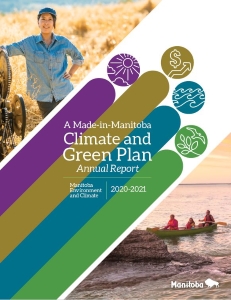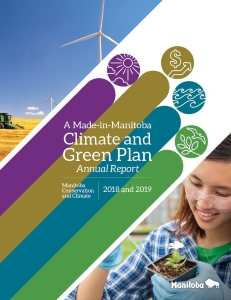 |
Climate and Green Plan
Made-in-Manitoba Climate and Green Plan
We know our climate is changing. The science is clear and conclusive. Climate change is real and is accelerating at an alarming rate. It is a serious threat to the well-being of Manitoba’s economy, ecosystems, and communities. But there is hope.
We asked Manitobans to tell us what their vision is for a cleaner, greener Manitoba. The result is the Made-in Manitoba Climate and Green Plan -- a bold new vision that builds upon our early, strategic investments in clean hydroelectricity.
Our vision is to make Manitoba Canada's cleanest, greenest, and most climate resilient province. It is a vision based on the strong foundations already put in place by Manitobans. It is a vision we can achieve with this strategic framework we are proposing to Manitobans.
Read the Made-in-Manitoba Climate and Green Plan (pdf 12.3 MB).
Made-in-Manitoba Climate and Green Plan Annual Report
The Annual Report is a whole-of-government document that tracks all of the many initiatives being undertaken to meet the goals of the Climate and Green Plan.
It reports on:
- programs and policies undertaken by government
- greenhouse gas emission reductions and the status of the Carbon Savings Account
- activities of the Expert Advisory Council
- funding under the Conservation & Climate Fund
- activities of the Low Carbon Government Office
In 2020-2021, the Manitoba government worked on 115 climate-related initiatives under the CGP. These initiatives differed in size, scope, and time frame. See Appendix 2 of the Annual Report for a full list. Some of the “big moves” that are highlighted include:
- The establishment of Efficiency Manitoba and its many programs
- The launch of the Conservation and Climate Fund
- The start up of the first generating unit of the Keeyask Generating Station
- The launch of the Manitoba Climate Resilience Training Project
- The launch of the Efficient Trucking Program
- The launch of an Organics Green Impact Bond
- The release of Manitoba’s Water Management Strategy
- The release of Manitoba’s Protein Advantage Strategy
- The launch of the Conservation and GROW Trusts
You can view the 2020-2021 Annual Report here.
You can view the 2018 and 2019 Annual Report here.
Manitoba's 2023-27 GHG Emissions Reductions Goal
The Manitoba government has set its greenhouse-gas emissions reduction goal for 2023 to 2027, as required in The Climate and Green Plan Implementation Act, based on the independent, scientific recommendations made by the Expert Advisory Council. Manitoba is the first jurisdiction in North America to establish an economy-wide carbon savings account. It provides a clear focus and pathway for governments, businesses, municipalities and communities and all Manitobans to take action in reducing emissions in a meaningful, practical and measurable way.
The Minister of Environment and Climate has received the Expert Advisory Council report and has accepted the Council's recommended goal for the 2023-2027 cumulative greenhouse gas emissions reductions. Read the Minister of Environment and Climate's response to the Expert Advisory Council’s recommendation ( English | French ).
This video demonstrates how the proposed carbon savings account plan in Manitoba will reduce emissions.
Efficient Trucking Program
Under the Low Carbon Economy Fund, Manitoba is taking climate action in the transportation sector. Heavy-duty vehicle emissions account for approximately 11 per cent of Manitoba's carbon pollution and Manitoba's Efficient Trucking Program will support retrofits in the transportation sector, such as, fuel-saving devices and technologies, reducing energy consumption, and providing environmental benefits. Visit the website for more information on the program or to apply today.
Merit-based Low Carbon Economy Fund (LCEF)
The Merit-based program offers $31.25 million in funding to support building and process improvements that reduce greenhouse gas (GHG) emissions and use of fossil fuels.
For full information and to access the on-line application for funding visit the Merit-based Low Carbon Economy Fund at Manitoba GO (Manitoba Grants Online) or contact the Climate and Green Plan Implementation Office at [email protected]
Manitoba Merit-Based Low Carbon Economy Fund - Program Overview
Conservation & Climate Fund
The Conservation and Climate Fund provides support to projects occurring in Manitoba that incorporate actions to combat and adapt to climate change and protect the environment.
Applications are not being accepted at this time. For more information on the Conservation and Climate Fund, visit the Manitoba GO (Manitoba Grants Online) website, or contact the Climate and Green Plan Implementation Office at [email protected].
First Nation Communities Engagement on Climate Adaptation in Manitoba
In early 2023, the Province of Manitoba, with the assistance of Scatliff + Miller + Murray, reached out to all First Nations in Manitoba to gain a better understanding of the observed and anticipated climate impacts within these communities and their traditional territories. Through a variety of in person and virtual engagement and an online survey, feedback was received from members of 26 of the 63 First Nations in Manitoba. The below links provide a two-page engagement summary and a short 1-minute video of what was learned from the project.


